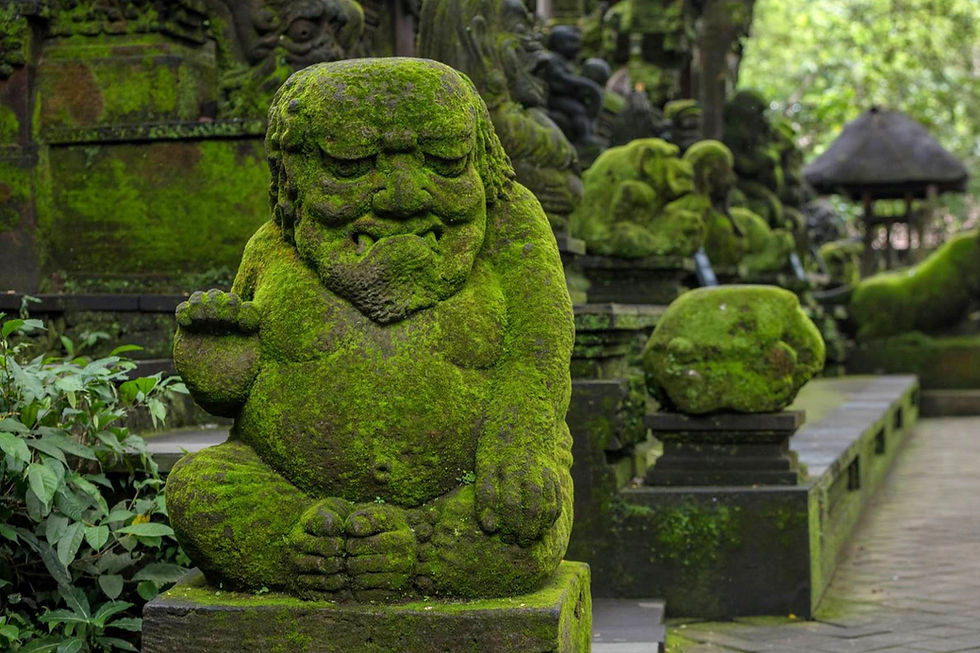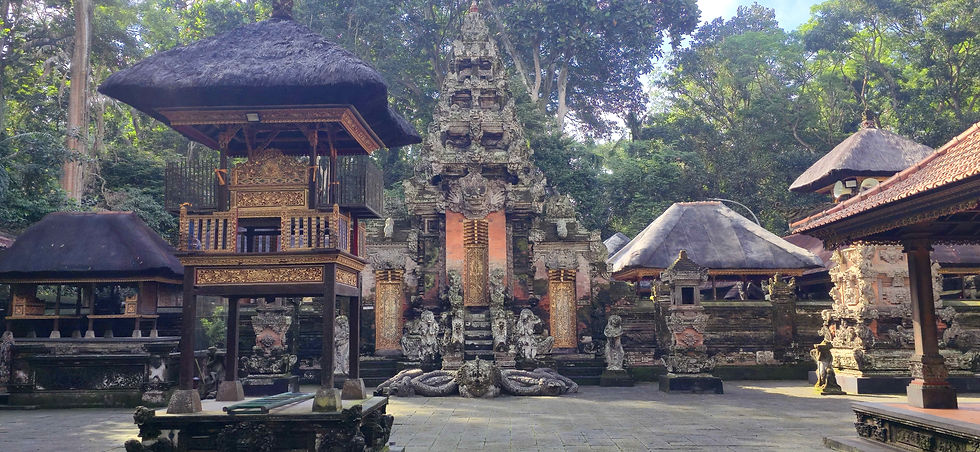The Great Temple of Death
- Shannon
- Sep 18
- 4 min read
Sacred Rituals Amid the Forest of Spirits
Agung Padangtegal Temple is one of the primary temples located within the Sacred Monkey Forest Sanctuary in Ubud, Bali. Established in the late 14th century, the temple serves as a key spiritual site for the local community, dedicated primarily to the worship of Hindu deities and various ancestral spirits. It is considered the main temple of the forest complex and plays a central role in religious ceremonies.

Also known as the Great Temple of Death, the complex is situated in the southwestern part of the monkey forest, in an area known locally as Mandala Wisata Wenara Wana. The site is characterised by traditional Balinese architecture, featuring stone shrines, carved gateways and tiered meru towers. Over time, the structures have weathered natural elements and are partially overgrown by surrounding jungle vegetation, which adds to the temple’s historic and sacred atmosphere.

Worship at the temple centres on Shiva, the Hindu god of destruction and purification, whose influence defines the site’s spiritual atmosphere. In Balinese Hinduism, destruction is embraced as a necessary phase in the cosmic cycle, clearing the way for renewal and spiritual liberation (moksha). Those who transcend worldly attachments are believed to reunite with Shiva’s formless divine state after death. The temple functions as a place where endings are respected as crucial moments in the journey toward spiritual growth and transformation. Ritual practices here focus on purification and seeking Shiva’s blessing to restore balance and cleanse the spirit. Set within the dense forest, the temple’s surroundings symbolise the passage through darkness required to reach enlightenment or rebirth. Local traditions hold that the forest itself is alive with spiritual energy, sometimes perceived as whispers or screams, reflecting the profound and often mysterious experience of death and change. For both devotees and visitors, the temple embodies the acceptance of destruction as an essential and sacred step toward new beginnings in both nature and spirit.

Agung Padangtegal Temple also honours the goddess Durga, who complements Shiva’s role with her fierce protective energy and embodiment of divine feminine power. Known as a warrior goddess who destroys evil, Durga’s presence at the temple emphasises the balance between masculine and feminine forces essential to spiritual harmony. Rituals dedicated to her invoke protection over the temple, forest and local community, reinforcing the temple’s role not only as a site of destruction and renewal but also as a sanctuary safeguarded against negative influences. Together, the worship of Shiva and Durga reflects the interconnected cycle of creation, preservation and transformation central to Balinese Hindu practice.
These ceremonies often include prayers, incense and offerings of flowers and food, intended to honour both the deities and the protective spirits believed to inhabit the forest. The Sacred Monkey Forest Sanctuary, including the temple grounds, is home to nearly 1300 long-tailed macaques. These monkeys are regarded not only as wildlife but also as spiritual guardians linked to the temple’s sacred function. According to Balinese Hindu belief, the monkeys are seen as intermediaries that protect the temple and its surrounding forest, helping to maintain the balance between nature and the spiritual realm.

Visitors to Agung Padangtegal are encouraged to show respect for both the temple and the forest. The site’s spiritual significance is emphasised by local guides and caretakers who explain that improper behaviour or disrespect can disrupt the harmony that the temple and its surroundings embody. The monkeys themselves can be protective and assertive, reflecting their cultural role as temple guardians. The temple and the broader forest sanctuary serve as a unique example of Balinese Hinduism’s integration with natural elements and wildlife. Agung Padangtegal illustrates how religious practice in Bali is deeply intertwined with environmental stewardship, where the preservation of sacred spaces supports both cultural traditions and biodiversity conservation.

Visitors to Agung Padangtegal are urged to respect both the temple and the surrounding forest, as local guides and caretakers stress that disrespect can disturb the delicate harmony maintained here. The temple and its sacred forest sanctuary exemplify the close relationship between Balinese Hinduism and the natural world, demonstrating how religious practices are deeply connected to environmental stewardship. This integration supports not only cultural traditions but also the conservation of the area’s unique biodiversity.

🗺️ Location
Jalan Monkey Forest, Padangtegal, Ubud Village, Bali, Indonesia
🚆 How to get there
The Monkey Sanctuary is located an easy 15 minute walk from downtown Ubud’s main street. There are two entrances to the Monkey Forest Sanctuary, one at Monkey Forest street and the other at Hanomen Street.
⭐ Attraction Info
The monkey forest is open daily, between 9am - 6pm. The entry fee is 100000 for adults / 80000 IDR for children on weekdays and 120000 for adults / 100000 IDR for children on weekends. You're better off to get there early in the morning or later in the afternoon when the crowds have died down. The park is big! Allow at least 2 hours to have a good look around.
🔗Official Website




































